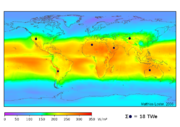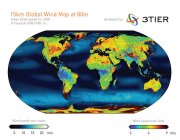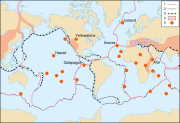energy sources,
foreign dependence
fossil fuels,
oil, petroleum, coal, natural gas, nuclear,
renewable energy sources,
biomass, hydropower, solar, wind, geothermal
. . .
(none)
Because of historical technological and economic circumstances, many regions
are dependent upon remote energy sources, in particular non-renewable
sources such as fossil fuels that are becoming more and more scarce and
expensive.
Foreign energy dependence equates to foreign economic dependence,
and since it takes energy to transport or transmit energy, the more
remote energy sources are the more they are inherently inefficient.
This problem exists in every region and country that is dependent upon
remote energy sources when local alternative sources are relatively
untapped.
We focus here on petroleum because, of all of the energy sources which
are not relatively local (much less renewable), the entire planet has
become addicted to oil,
so it is the prime example of risky foreign energy dependence.
In principle, however, the general problem applies to dependence on
any remote source of energy (especially if non-renewable),
whether it be petroleum, other fossil fuels such as natural gas,
hydroelectric transmission to desert regions without a major river or
an ocean coastline, or even whale oil.
Oil Addiction
One of the most revolutionary discoveries in the world was the discovery
that petroleum wasn't just a lubricant, but that it could be refined into
gasoline, diesel and other fuels to power machinery.
This ushered in the greatest leap in industrial production and standards of
living the world has ever seen.
It was a
good thing and globally we are still reaping the benefits.
Unfortunately petroleum is not renewable - there are no more mass
extinctions of dinosaurs and other forms of life.
(Although we note that there are other theories about where all of the oil
came from in the first place.)
This has led to shifting economic and strategic balances among nations, and
competition for petroleum sources has been a major cause of at least one world
war, and a factor in numerous other "limited" regional wars.
We will always have some dependence on oil, and it has served us well for
over a century.
But the costs aren't just economic as the price of crude oil goes up with
increasing global demand.
Since burning petroleum products is not particularly clean, they are a major
source of pollution and global warming.
Continued dependence on oil, especially in regions that don't have much
of their own, is a severe threat to environmental health, as well
as an economic and strategic threat to security.
Here are some data about oil in the USA from the CIA World Factbook as of
October 2008:
-
Oil - production:
7.46 million bbl/day (2007 est.)
This is about 35% of the 2005 daily consumption.
-
Oil - consumption:
20.8 million bbl/day (2005 est.)
2008 figures of about 21 million barrels per day are about the same.
This is nearly 25% of the 85 million barrels produced globally per day
(for 4% of the global population).
-
Oil - exports:
1.048 million bbl/day (2004)
-
Oil - imports:
13.15 million bbl/day (2004)
This was about 63% (13.15/20.8) of the US oil consumption.
Some say the 2008 figure is 70%, up from 24% in 1970.
Assuming 2004 import levels,
at $100 per barrel this means the US spends $1.315 billion to import
foreign oil every day, or $480 billion per year.
At the $146.27 per barrel peak in July 2008, that would be $707 billion
annually.
($7 billion more than the $700 billion "bailout" of 2008.)
-
Oil - proved reserves:
21.76 billion bbl (1 January 2006 est.)
To put these figures in some perspective, let's consider just the
economic impact on the average US commuter.
In 2008 the average commute to work in the US was about 25 miles.
That's 50 miles per day, 250 miles per week, 1000 miles per month
just to go round trip to work.
We've found EPA data for "light-duty" vehicles, including cars, vans,
SUVs and pickups, that varied from 19.7 to 21 mpg in 2005 and 2006.
Some estimate the average gas mileage for light-duty vehicles fell to
17 mpg by 2008, partially due to the increasing popularity of light-weight
trucks and SUVs.
Assuming a average of 20 mpg per vehicle, that's an average of 50 gallons
of gasoline per month.
(This discounts those who take public transportation to work, but that is
offset by sitting in traffic jams on congested highways.)
For every dollar that gasoline goes up, that's an extra average $50
per month that each worker pays just to go to his or her job!
According to the CIA World Factbook, the US labor force in 2007 was
a little over 153 million people.
Assuming an unemployment rate of 5%, that's about 145 million who have
jobs.
In total, therefore, US workers drive
145 billion miles per month, burning 7.25 billion gallons of gasoline
(at 20 mpg), and every time its price goes up a dollar the nation
spends another $7.25 billion just for a month's commuting.
If gasoline goes up a buck and stays there, that alone costs our labor
force $87 billion more a year to go to work.
In 10 years this would exceed the $700 billion "bailout" of 2008
by $170 billion.
And most of that goes to foreign oil producers.
Now consider the impact of burning petroleum fuels for overground shipping,
to take the kids to school, to go shopping, to go on vacations,
and so on, plus the inflationary impact on products, food, etc.
For families on a tight budget, it's enough to force them to buy less,
to put off paying bills, and to make their mortgages go toxic.
Global Energy Sources
All energy sources are ultimately from radiation or from kinetic energy
(motion).
Radiation can come from radioactivity, such as from uranium for nuclear
reactors and geothermal heat which is mostly from the radioactive decay of
elements, or from the sun's nuclear fusion, such as infrared heat and
ultraviolet energy used by plants in photosynthesis.
As the entire food chain ultimately traces back to photosynthesis,
fossil fuels and biomass are essentially stores of solar radiation.
Kinetic energy sources include the fluid flows of water in rivers, ocean
currents and tides, and of wind.
These are driven by the rotation of the earth, gravity, and heat
differentials which are in turn largely driven by solar radiation
(and some friction).
What are the largest energy resources?
Global energy usage breaks down like this:
Oil 37%, Coal 25%, Gas 23%, Nuclear 6%, Biomass 4%, Hydro 3%,
Solar Heat 0.5%, Wind 0.3%, Geothermal 0.2%, Biofuels 0.2%,
Solar Photovoltaic 0.04%
Note that the first four, totalling 91% of global usage, are
non-renewable, and the remaining 9% are renewable.
Non-renewable Energy Sources
A non-renewable energy source is a local energy resource proportional
to where the largest reserves exist (particularly per capita), and
inversely proportional to where reserves are relatively scarce, and
at the extreme where they don't exist at all (such as oil in Japan).
So where are the non-renewable sources located from which the world gets 91%
of its energy?
-
Oil (37%)
The 2008 rank order of estimated oil reserves by country in billions
of barrels is:
Saudi Arabia (267), Canada (179, 95% in oil sands), Iran (138),
Iraq (115), Kuwait (104), United Arab Emirates (98), Venezuela (87),
Russia (82 per Russian oil companies but estimates vary wildly
from 60 to 180),
Libya (41), Nigeria (36), Kazakhstan (30),
United States (21 with another .727 in the strategic petroleum reserve),
China (16), Qatar (15), Algeria (12), Brazil (12), and Mexico (12).
-
Coal (25%)
The 2006 top 10 proved recoverable coal reserves by country in
millions of tons:
United States (246,643), Russia (157,010), China (114,500),
India (92,445), Australia (78,500), South Africa (48,750),
Ukraine (34,153), Kazakhstan (31,279), Poland (14,000),
Brazil (10,113).
-
Natural Gas (23%)
The 2006 top 10 proved natural gas reserves by country in trillions
of cubic meters:
Russia (47.57),
Iran (26.37),
Qatar (25.79),
Saudi Arabia (6.568),
United Arab Emirates (5.823),
United States (5.551),
Nigeria (5.015),
Algeria (4.359),
Venezuela (4.112),
European Union (3.310),
Iraq (3.170).
Note, however, that biogas, i.e. biomethane from biomass, is a
renewable source of "natural gas".
-
Nuclear (uranium) (6%)
Today's nuclear power plants are fission reactors fueled by uranium,
so nuclear reserves are uranium reserves.
The 2008 top 10 known uranium reserves by country (96% of the
global supply) in thousands of tons:
Australia (460), Canada (426), Kazakhstan (254), South Africa (186),
Brazil (112), Nambia (110), Uzbekistan (109), United States (102),
Niger (94), Russia (75).
Note, however, that much of the world has not been explored for
uranium, there was little uranium exploration from 1985 through 2005,
and that significant uranium supplies come from secondary sources,
such as decommissioned nuclear weapons, reprocessing and
re-enrichment.
Renewable Energy Sources
All of our energy sources are to some extent renewable.
Given eons of time, more materials that naturally emit radiation,
like uranium, could be produced by stars like our sun.
Given another stretch of time that life has existed on earth (and given a
mass extinction or three) fossil fuels, including petroleum, could be
renewed.
But for practical purposes, renewable energy sources are those that
are naturally continuous, such as the daily bath of solar radiation,
geothermal heat, the daily movement of wind and water, and the seasonal
growth and death of biomass, organic life which essentially stores
and recycles the solar energy from whatever it consumes.
Local energy sources that are also renewable are the best because the locale
will never run out of them.
Throughout the world there are vast renewable energy resources which are
grossly underutilized.
So where are the renewable sources from which the world currently
gets only 9% of its energy?
-
Biomass (4%)
and
Biofuels (0.2%)

NASA composit photo of the earth revealing major biomass areas
Going back to when cavemen discovered fire, the oldest source
of renewable energy is biomass, any plant (or animal) material
that will burn or decompose.
Biomass is a local energy source wherever there is life, the
denser the better, but not all biomass has the same renewable
energy potential, using some biomass for energy competes with
other uses such as for food and for industrial and building
materials, and different uses of biomass for energy have varying
environmental impacts.
The major ways energy is extracted from biomass are:
A) burning it,
B) producing biogas, and
C) producing biofuels.
-
Burning biomass is a source for space heating and industrial heat,
from camp fires to the industrial production of electricity.
Burning wood has always been and remains the largest source of
bioenergy because it is generally denser, hence has more energy per
volume, than other biomass sources.
While burning biomass contributes to amounts of particulate
pollution (smoke) depending upon the combustion technology
used, it is "carbon neutral" because it doesn't release any
more carbon dioxide than decomposition, i.e., letting it rot.
Wood and other woody materials are local energy sources
wherever there are forests and brush, but other uses for wood
make depletion a concern requiring smart forestry policies.
-
As biogas, namely biomethane, can be produced by the anaerobic
decomposition of any organic matter, in particular plant
and animal wastes (including manure and sewage), this is a
biomass energy source that is globally local, particularly in
agricultural and urban areas.
An added benefit of getting biogas from decomposing biomass,
especially as opposed to burning it, is that the material left
is a valuable fertilizer.
It also reduces the methane, a greenhouse gas, that would
otherwise be released into the atmosphere from sources like
landfills.
-
Biofuels primarily include ethanol (ethyl alcohol), which
is produced by fermenting and distilling plants that are
high in sugar, starch or cellulose, and biodiesel, which is
produced from plants that are high in vegetable oil.
It doesn't make much environmental or economic sense to use
crops that are valuable food sources directly for biofuel
production, unless there is a considerable amount of surplus.
It's better to concentrate on making biofuels from
plant wastes, such as crop residues, although there are
competing uses for plant waste too, like producing biogas
and fertilizer.
Currently biofuels are local energy sources in regions where
certain agricultural products are grown.
In the US ethanol is produced from maize (corn), soybeans
and switchgrass (a native American tallgrass).
Europe produces biodiesel from rapeseed and ethanol from wheat and
sugar beets.
Brazil produces large quantities of ethanol from sugar cane.
In southeast Asia diesel is produced from palm oil and ethanol is
produced from the tropical grass miscanthus.
China produces ethanol from sorghum and cassava.
India produces biodiesel from jatropha.
-
Hydropower (3%)
Hydropower is available everywhere there are large amounts of water
that move naturally, namely where there are rivers and oceans.
Water wheels and watermills providing mechanical energy are the
oldest forms of hydropower, a local resource wherever there is
a stream or river, but most hydropower today uses water motion to
produce electricity.
Hydroelectric dams currently utilize the most hydropower,
producing 16.4% of the world's electricity in 2005, but
they are not practical wherever there are rivers.
Rivers meandering through plains, such as most of the Missouri,
Ohio and Mississippi rivers in the US, would require incredibly
wide dams that would flood vast areas of valuable agricultural
land.
Therefore, hydroelectric dams are feasible local sources of energy only
where rivers run through narrow valleys and channels between
high surrounding hills and cliffs, the faster moving (due to
drops in elevation) the better.
However, new "micro-hydro" and damless hydropower technologies,
essentially water wheels that spin small generators, are being
developed which can be installed in any relatively fast running
river or stream.

Map of significant tidal stream resources
Electricity can also be generated with tide powered turbines,
and almost every coastal area could utilize tidal power as an
electric power source,
but tidal energy is not uniform along every ocean coastline.
Tide levels vary depending on the depth and shape of the coastal
sea floor.
Some places have one tide per day (diurnal tides) and some have two
per day (semi-diurnal tides).
Tides also vary over time, a function of the relative orbits of the
Earth around the sun, and the moon around the Earth.
Where the coastal seabed is shallow the tidal motion is relatively
horizontal, producing a tidal stream or current; where it is
steep the tidal motion is relatively vertical.
Different tide generators operate on these different directions,
but tidal stream locations are the more plentiful and economical.
Tidal streams flow in and out of bays and river mouths,
and through narrow passages between dry land, such as the
English Channel and the Straits of Gibraltar and Istanbul.
While tidal streams are found along the coasts of every continent,
some of the largest are along the western and southern coasts of
Alaska, Hudson Bay and the Bay of Fundy in Canada, three spots on
the Atlantic coast of South America, the coasts of the British
Isles and France, the northwest coast of Africa, the coasts
of Madagascar, the East China Sea, and the coastlines between
Indonesia and Australia.
In the US other significant tidal stream areas include the coasts
of New England, central California and the tip of Florida.
On the horizon are new technologies to generate electricity
from marine currents, particularly where the currents are near
land such as where the Gulf Stream flows through the Straits of
Florida, and wave power.
-
Solar Heat (0.5%)
and
Solar Photovoltaic (0.04%)

Average global insolation factoring in cloud cover
The measure of solar energy received on a surface area is
called insolation.
One of the most universally available renewable resources,
solar energy is available everywhere the sun shines, but more so where
it shines the most throughout the year - where insolation is greatest.
Generally, the nearer a locale is to the equator the more sunlight
is available annually.
Obviously more sunlight is available in locales that are
relatively not overcast, i.e., where it doesn't rain much.
In areas where there are canopies of vegetation, such as in rain
forests, available sunlight at the ground level is diminished
unless the vegetation is cleared, which would have its own
harmful environmental impacts.
It's better to let solar energy produce biomass in these areas.
Therefore solar energy is the most locally available in "sun belts",
namely arid or semi-arid regions, the closer to the equator the
better.
Ideal areas for solar energy include Mexico and the southwest US in
North America, most of South America (except the rain forest), the
Caribbean, Africa (except the rain forest), the mid-East, southern
Asia and Australia.
Significant areas for solar energy include the rest of the US and
southern Canada, and
a belt stretching through southern Europe then eastward through
central and southeast Asia.
However, solar energy is a valuable supplemental energy source
for any locale.
-
Wind (0.3%)

Mean global wind speeds for 2005, by the 3TIER Group
One of the most universally available renewable resources,
wind power is available wherever the wind blows, especially where the
average annual wind speeds are the highest.
These places include large areas of North America, especially
the western coast of Alaska, the great plains of the US and
eastern Canada, the southern and eastern tips of South America,
especially Tierra del Fuego, Greenland, most of Europe, especially
Britain and northern Europe into Russia, northern Africa as well
as Ethiopia, Somalia and Kenya on the east, eastern Asia, most
of Australia, most of Anarctica, and anywhere there are mountains.
At sea these also include the north Pacific and Atlantic oceans,
the southern Indian ocean, and even more so the entire oceanic
belt encircling Anarctica.
Coastlines along these ocean areas would also generally be good
sites for wind power, especially if these areas were coastal
mountains.
-
Geothermal (0.2%)

Global geothermal map showing plate boundaries and zones with some
hotspots
Where the Earth's crust is geologically unstable or thin the Earth's
heat can be tapped for geothermal energy.
Surface heat is highest where the Earth's magma is close to the
surface: hotspot areas where there are (or used to be) volcanoes and
areas along tectonic boundaries.
Hotspots include places like the Hawaiian Islands and the Yellowstone
Caldera in the US.
Tectonic boundaries are places
where the Earth's plates are spreading apart (divergent plate
boundaries) such as Iceland, or colliding together (convergent plate
boundaries) such as the Pacific Ring of Fire.
The best places for geothermal energy exploitation are where
hotspots and plate boundaries are on coastlines or inland rather
than in the middle of an ocean.
The largest of these comprise the Pacific Ring of Fire, which
includes the west coast of the Americas, the Aleutian Islands, the
island nations off the east coast of the Asian mainland, including
Japan and the Philippines, Indonesia, New Guinea, and New Zealand.
Another skirts the northern coast of Algeria, stretches eastward
through southern parts of Europe, then connects to Asia north
of the Persian Gulf and the Himalayas.
Large inland zones of geothermal sources include the western
United States, a huge belt through southern Europe, Turkey, Iran,
Pakistan, Afghanistan, northern India, southeast Asia and a most
of inland China,
and a belt that stretches inland from the eastern coast of Africa
south of the Red Sea.






